Local Optimization and Curve Fitting
Contents
Local Optimization and Curve Fitting#
Note
This lecture is going to:
Quickly review why we care about finding minima and maxima of functions
Demonstrate three methods for finding minima/maxima:
Evaluate the function at a bunch of points and find the minimum one
Using a non-linear solver to find where the gradient is zero
Using a local optimizer from scipy
Demonstrate but not discuss in detail global
Show that finding minima and maxima are the same problem
After covering these ideas, we will practice on a problem that we can also solve with ODE events!
Function extrema#
It is pretty common to need to find extreme values of a function in engineering analysis. An extreme value is often a maximum or minimum in a function, and we seek them when we want to maximize a profit function, or minimize a cost function, identify a maximum safe operating condition, etc.
Let’s consider an example function with a graphical solution approach. We want a quantitative estimate of the minimum in this function.
import matplotlib.pyplot as plt
import numpy as np
def f(x):
return x**2 + np.exp(-5 * x**2)
x = np.linspace(0, 2)
y = f(x)
plt.plot(x, y)
[<matplotlib.lines.Line2D at 0x7f05087f1220>]
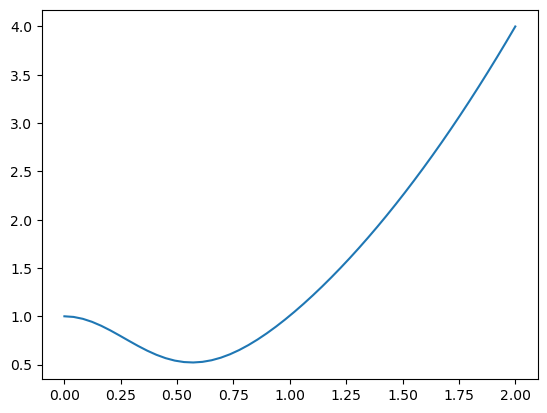
You can see there is a minimum near 0.6. We can find the minimum in a crude kind of way by finding the index of the minimum value in the y-array, and then getting the corresponding value of the x-array. You control the accuracy of this answer by the number of points you discretize the function over.
x = np.linspace(0, 2, 50)
y = f(x)
i = np.argmin(y)
x[i]
0.5714285714285714
Tip
Pros/cons of finding minima/maxima by inspection!
Pros:
It is easy.
You see the whole domain you are looking at, and it is easy to see how many extrema their are
Cons:
Lot’s of function evaluations. Imagine if it took a long time to compute each value.
Somewhat tedious.
Not so easy to reproduce
Not scalable to large problems, your time to do this becomes a limiting factor.
Find the derivative, and solve for where it is zero#
We can also derive the first derivative:
\(y' = 2x + e^{-5 x^2} (-10x)\)
and solve it for zero using fsolve.
def yp(x):
return 2 * x + np.exp(-5 * x**2) * (-10 * x)
from scipy.optimize import fsolve
fsolve(yp, 0.5)
array([0.56735137])
These two answer agree to 5 decimal places.
This depends on your ability to correctly derive and implement the derivative. It is good to know you can solve this problem by more than one method. Here, we use a numerical derivative in the function instead to check our derivative. You can check the convergence of the derivative by varying the dx.
from scipy.misc import derivative
def ypd(x):
return derivative(f, x, dx=1e-6)
fsolve(ypd, 0.5)
array([0.56735137])
These look the same within tolerance. This is not a beautiful solution, but it is hard to argue with success here!
Tip
Pros/cons of finding minima/maxima by root finding of the derivatives!
Pros:
We’ve turned a new problem into a different numerical problem that might be easier to solve
Cons:
You have to do a derivative by hand or use a numerical estimate.
You get minima, maxima, and saddle points.
Standard python approach: scipy.optimize.minimize#
Here is the basic use of scipy.optimize.minimize. As always, we should plot the answer where feasible to make sure it is the minimum we wanted.
See also
Full documentation and notes on types of algorithms: https://docs.scipy.org/doc/scipy/reference/generated/scipy.optimize.minimize.html
More notes on various optimization techniques implemented in scipy: https://docs.scipy.org/doc/scipy/tutorial/optimize.html#optimization-scipy-optimize
from scipy.optimize import minimize
def f(x):
return x**2 + np.exp(-5 * x**2)
guess = 0.5
sol = minimize(f, guess)
sol
fun: 0.5218875824868201
hess_inv: array([[0.15524504]])
jac: array([4.47034836e-08])
message: 'Optimization terminated successfully.'
nfev: 10
nit: 3
njev: 5
status: 0
success: True
x: array([0.56735137])
x = np.linspace(0, 2)
y = f(x)
plt.plot(x, y, "b-")
plt.plot(sol.x, f(sol.x), "ro")
plt.xlabel("x")
plt.ylabel("y")
plt.legend(["f(x)", "fmin"])
<matplotlib.legend.Legend at 0x7f0506890880>
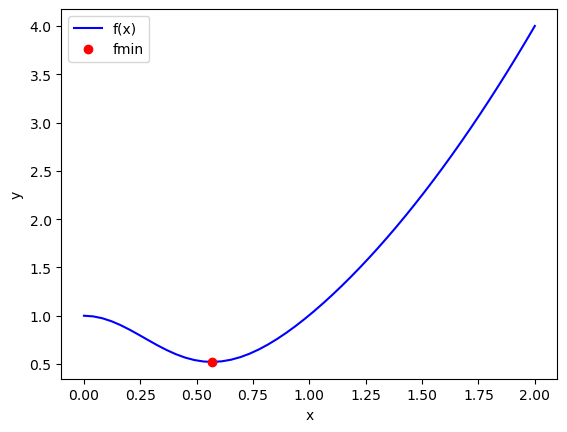
Note this answer is only the same in the first 4 decimal places. Remember that these iterative approaches stop when a tolerance is met. Check the defaults on fmin!
Multiple minima#
It is possible for functions to have more than one minimum. In this case, your guess will determine which minimum is found. Here is an example where there is a minimum near 2.2, and one near 4.5.
def h(x):
return 2 + np.cos(x) + np.cos(2 * x - 0.5) / 2
x = np.linspace(0, 2 * np.pi)
plt.plot(x, h(x))
plt.xlabel("x")
plt.ylabel("h(x)")
Text(0, 0.5, 'h(x)')
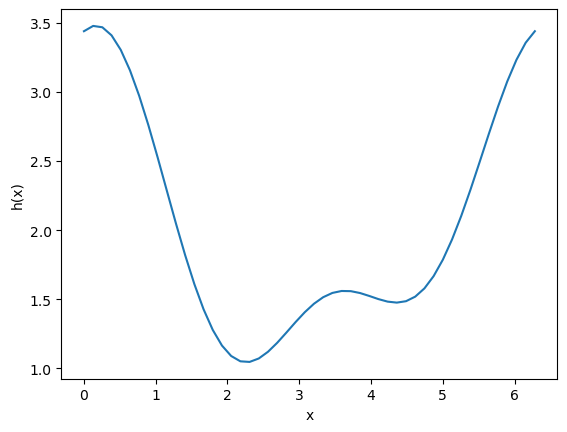
This guess finds the one near 2.2:
minimize(h, 2)
fun: 1.0448871783746692
hess_inv: array([[0.52336562]])
jac: array([-1.49011612e-08])
message: 'Optimization terminated successfully.'
nfev: 10
nit: 3
njev: 5
status: 0
success: True
x: array([2.26106175])
and this guess finds the one near 4.5
minimize(h, 4)
fun: 1.4758979742813436
hess_inv: array([[0.94727357]])
jac: array([-9.08970833e-07])
message: 'Optimization terminated successfully.'
nfev: 14
nit: 5
njev: 7
status: 0
success: True
x: array([4.355456])
You have to decide which one is better for the problem at hand. If this were a cost function, the one at the lower cost is probably better! Note that all we can say here is which one is lower in the interval we are looking at. By inspection of the function, you can see it will be periodic, so there will be many other minima that also exist.
See also
Questions about local vs global minima and their use in decision making for engineering can be very interesting. You will discuss this in much more detail in your second mini (optimization) this semester!
Animation of minima finding#
Just like in ODE Integration (with Events!), we can visualize the points that are being sampled by the numerical method to find the local minimum. First, we’ll make a quick wrapper function to save the function evaluations during the minimization.
def wrap_function_save_eval(x, function, function_eval_save):
y = function(x)
function_eval_save.append((x, y))
return y
# List to contain all of the function evaluations
function_eval_save = []
x0 = 1
sol = minimize(wrap_function_save_eval, x0, args=(h, function_eval_save))
Now, we’ll use the saved points to make a quick animation of the solution process.
import matplotlib.pyplot as plt
import numpy as np
from IPython.display import HTML
from matplotlib import animation, rc
# First set up the figure, the axis, and the plot element we want to animate
fig, ax = plt.subplots()
plt.close()
# Add the analytical solution
x = np.linspace(0, 2 * np.pi)
ax.plot(x, h(x))
ax.set_xlabel("x")
ax.set_ylabel("y")
ax.set_xlim([-1, 7])
ax.set_ylim([0, 4])
# Make a blank line and quiver to hold the data points as they get evaluated
(line,) = ax.plot([], [], "or", label="Function evaluations")
(linefinal,) = ax.plot([], [], "ok", label="Latest function evaluation")
ax.legend()
# initialization function: plot the background of each frame
def init():
line.set_data([], [])
linefinal.set_data([], [])
return (line, linefinal)
# animation function. This is called sequentially
def animate(i):
# unzip the t, y, and yp vectors as separate vectors
x, y = zip(*function_eval_save)
# Set the data for the line
line.set_data(x[:i], y[:i])
linefinal.set_data(x[i - 1], y[i - 1])
return (line, linefinal)
# Make the animation!
anim = animation.FuncAnimation(
fig,
animate,
init_func=init,
frames=len(function_eval_save) + 1,
interval=1000,
repeat_delay=5000,
blit=True,
)
# Note: below is the part which helps it work on jupyterbook
rc("animation", html="jshtml")
anim
Finding maxima#
minimize is for finding minima (no surprise!). We can use it to find maxima though, by finding the minima of \(-f(x)\). You can see here that when we plot \(-h(x)\) the minima become maxima, and vice-versa. Now you can see there are two definite minima, one near zero, and one near 3.5, which correspond to the maxima of \(h(x)\).
plt.plot(x, -h(x))
plt.xlabel("x")
plt.ylabel("-h(x)")
Text(0, 0.5, '-h(x)')
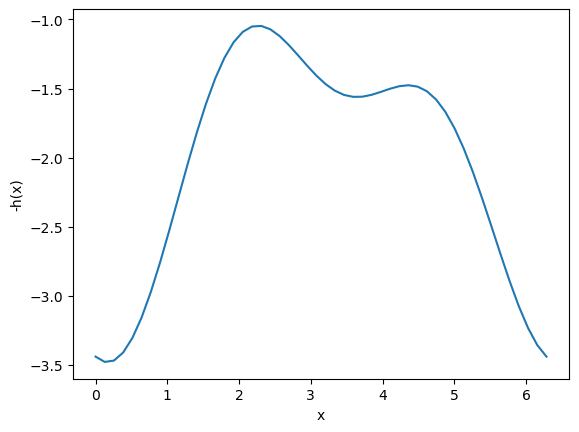
The standard way to use minimize is to define an optional argument for the sign that defaults to one. Then, when we call fmin, we will pass -1 as the sign to the function, so we find the minimum of -h(x). Then, we evaluate h(x) at that x-value to get the actual value of the maximum. It is not necessary do this, you can also manually pass around the sign and try to keep it straight.
Here is an example to find the maximum near 3.5.
def h(x, sign=1):
return sign * (2 + np.cos(x) + np.cos(2 * x - 0.5) / 2)
sol = minimize(h, 3.5, args=(-1,)) # set sign=-1 here to minimize -h(x)
print(h(sol.x)) # sign defaults to 1 here, so we get the maximum value
plt.plot(x, h(x))
plt.plot(sol.x, h(sol.x), "ro")
plt.xlabel("x")
plt.ylabel("h(x)")
[1.56120872]
Text(0, 0.5, 'h(x)')

Once again, here you have to decide which maximum is relevant
Practice with functions of multiple variables#
As practice, find the lowest of the local minima for the function \((x^2+y-11)^2+(x+y^2-7)^2\) in the domain \(x\in[-5,5],y\in[-5,5]\), visualized below!
Tip
minimize can work with functions of multiple variables. Just like solve_ivp! It will expect a function with a vector input. You can unpack and use the variables with similar code like:
def f(X):
x, y = X
return x + y
minimize(f, [x0, y0])
# Set limits for x/y
xrange = np.linspace(-5, 5)
yrange = np.linspace(-5, 5)
# Make 2d arrays for all the unique values of x/y
xgrid, ygrid = np.meshgrid(xrange, yrange)
# Generate the plot ofthe
zgrid = (xgrid**2 + ygrid - 11) ** 2 + (xgrid + ygrid**2 - 7) ** 2
# Plot the function as a filled contour!
plt.contourf(xgrid, ygrid, zgrid, 60, cmap="jet")
plt.clim([0, 400])
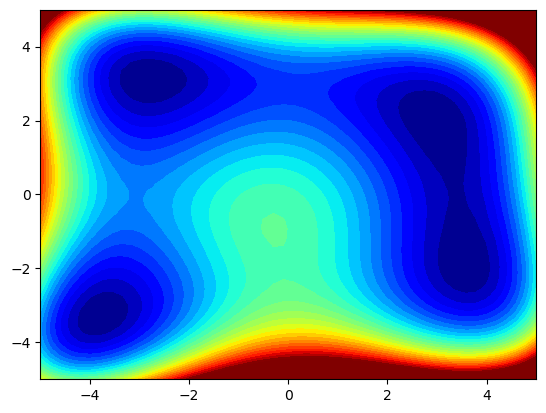
Global optimization#
We just covered how to do local optimization with scipy. Specifically, starting with a guess, we used an algorithm to iteratively update the guess to find a local minimum.
We also showed that there are many functions that have multiple local minima. We knew this because we could plot the function and see the minima. But what do we do if there are multiple minima? We basically have two options:
Use optimization or PSE techniques to rigorously find the minima (what you will cover in the second mini of this semester)
Use a heuristic strategy to find the global minima
We will solve the above example using one of the built-in scipy global optimizers, but be aware
There are no guarantees you will find the global minima
It might be slow or take many evaluations
You will probably have to play with various optimizer settings For all of these reasons, the methods you learn in 06-326 are the better choice if you can frame your problem in the right way to take advantage of them!
from scipy.optimize import basinhopping
def wrap_function_save_eval(x, function, function_eval_save):
y = function(x)
function_eval_save.append((x, y))
return y
# List to contain all of the function evaluations
function_eval_save = []
x0 = 5
sol = basinhopping(
lambda x: wrap_function_save_eval(x, h, function_eval_save),
x0,
T=1,
stepsize=2,
niter=3,
)
import matplotlib.pyplot as plt
import numpy as np
from IPython.display import HTML
from matplotlib import animation, rc
# First set up the figure, the axis, and the plot element we want to animate
fig, ax = plt.subplots()
plt.close()
# Add the analytical solution
x = np.linspace(0, 2 * np.pi)
ax.plot(x, h(x))
ax.set_xlabel("x")
ax.set_ylabel("y")
ax.set_xlim([-1, 7])
ax.set_ylim([0, 4])
# Make a blank line and quiver to hold the data points as they get evaluated
(line,) = ax.plot([], [], "or", label="Function evaluations")
(linefinal,) = ax.plot([], [], "ok", label="Latest function evaluation")
ax.legend()
# initialization function: plot the background of each frame
def init():
line.set_data([], [])
linefinal.set_data([], [])
return (line, linefinal)
# animation function. This is called sequentially
def animate(i):
# unzip the t, y, and yp vectors as separate vectors
x, y = zip(*function_eval_save)
# Set the data for the line
line.set_data(x[:i], y[:i])
linefinal.set_data(x[i - 1], y[i - 1])
return (line, linefinal)
# Make the animation!
anim = animation.FuncAnimation(
fig,
animate,
init_func=init,
frames=len(function_eval_save) + 1,
interval=1000,
repeat_delay=5000,
blit=True,
)
# Note: below is the part which helps it work on jupyterbook
rc("animation", html="jshtml")
anim
Regression of data is a form of function minimization#
When we say regression, we really mean find some parameters of a model that best reproduces some known data. By “best reproduces” we mean the sum of all the errors between the values predicted by the model, and the real data is minimized.
Suppose we have the following data that shows how the energy of a material depends on the volume of the material.
See also
Note that below we used pandas to read a CSV (comma separated value) file! You can read more about pandas here:
import matplotlib.pyplot as plt
import numpy as np
import pandas as pd
# Import csv using a pandas dataframe!
df = pd.read_csv("review_optimization.csv")
volumes = df["volumes"].values
energies = df["energies"].values
plt.plot(volumes, energies, "bo")
plt.xlabel("V")
plt.ylabel("E")
Text(0, 0.5, 'E')
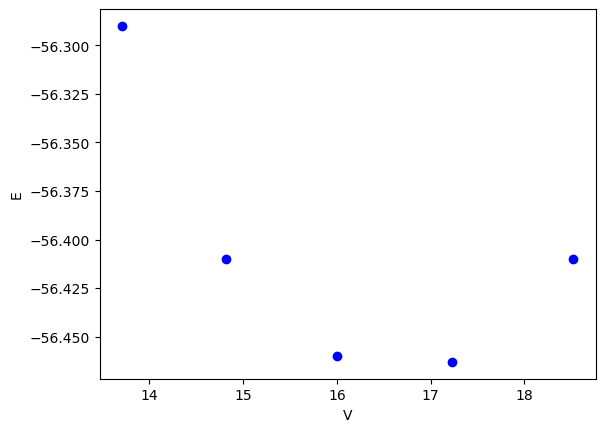
In Materials Science we often want to fit an equation of state to this data. We will use this equation:
\(E = E_0 + \frac{B_0 V}{B_0'}\left(\frac{(V_0 / V)^{B_0'}}{B_0' - 1} + 1 \right) - \frac{V_0 B_0}{B_0' - 1}\)
from https://journals.aps.org/prb/pdf/10.1103/PhysRevB.28.5480. In this model there are four parameters:
name |
desc |
|---|---|
E_0 |
energy at the minimim |
B_0 |
bulk modulus |
B_0’ |
first derivative of the bulk modulus |
V_0 |
volume at the energy minimum |
We would like to find the value of these parameters that best fits the data above. That means, find the set of parameters that minimize the sum of the squared errors between the model and data.
First we need a function that will use the parameters and return the energy for a given volume.
def Murnaghan(parameters, vol):
"From PRB 28,5480 (1983)"
E0, B0, BP, V0 = parameters
E = E0 + B0 * vol / BP * (((V0 / vol) ** BP) / (BP - 1) + 1) - V0 * B0 / (BP - 1.0)
return E
Next, we need a function that computes the summed squared errors for a set of parameters. The use of squared errors is preferable in many cases to the absolute values because it has a continuous derivative. We will learn more about this later.
def objective(pars):
err = energies - Murnaghan(pars, volumes)
return np.sum(err**2) # we return the summed squared error directly
Finally, we need an initial guess to start the minimization. As with all minimization problems, this can be the most difficult step. It is always a good idea to use properties of the model and data where possible to make these guesses. We have no way to plot anything in four dimensions, so we use analysis instead.
We can derive some of these from the data we have. First, we can get the minimum in energy and the corresponding volume that we know from the data. These are not the final answer, but they are a good guess for it.
The B0 parameter is related to the curvature at the minimum, which is the second derivative. We get that from repeated calls to numpy.gradient. Finally, \(B_0'\) is related to the derivative of \(B\) at the minimum, so we estimate that too.
imin = np.argmin(energies)
dedv = np.gradient(energies, volumes)
B = np.gradient(dedv, volumes)
Bp = np.gradient(B, volumes)
x0 = [energies[imin], B[imin], Bp[imin], volumes[imin]]
x0
[-56.463, 0.02575384116153356, -0.00900405886406903, 17.23]
Finally, we are ready to fit our function. As usual, we also plot the data and the fit for visual inspection.
from scipy.optimize import minimize
sol = minimize(objective, x0)
print(sol)
plt.plot(volumes, energies, "bo", label="Data")
vfit = np.linspace(min(volumes), max(volumes))
plt.plot(vfit, Murnaghan(sol.x, vfit), label="fit")
plt.legend()
plt.xlabel("V")
plt.ylabel("E")
fun: 1.4912965344598558e-05
hess_inv: array([[ 3.03863745e-01, -3.02573371e+00, 8.04371522e+01,
-2.41676767e+00],
[-3.02573371e+00, 5.27761683e+01, -1.63584644e+03,
4.76079594e+01],
[ 8.04371522e+01, -1.63584644e+03, 7.06615880e+04,
-2.81868629e+03],
[-2.41676767e+00, 4.76079594e+01, -2.81868629e+03,
1.54690538e+02]])
jac: array([ 3.46717718e-06, 1.36594349e-06, 7.79607490e-09, -5.30043053e-07])
message: 'Optimization terminated successfully.'
nfev: 180
nit: 31
njev: 36
status: 0
success: True
x: array([-56.46839794, 0.57236216, 2.74084063, 16.55900277])
Text(0, 0.5, 'E')
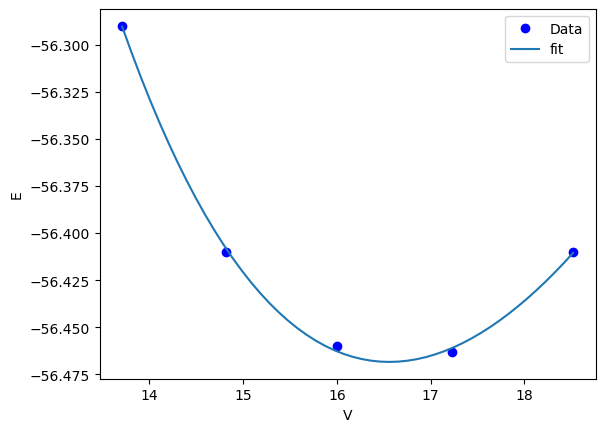
That looks pretty good. We should ask ourselves, how do we know we got a minimum? We should see that the objective function is really at a minimum for each of the parameters. Here, we show that it is a minimum for the first parameter.
E0_range = np.linspace(0.9 * sol.x[0], 1.1 * sol.x[0])
errs = [objective([e0, *sol.x[1:]]) for e0 in E0_range]
plt.plot(E0_range, errs)
plt.axvline(sol.x[0], c="k", ls="--")
plt.xlabel("E0")
plt.ylabel("summed squared error")
Text(0, 0.5, 'summed squared error')
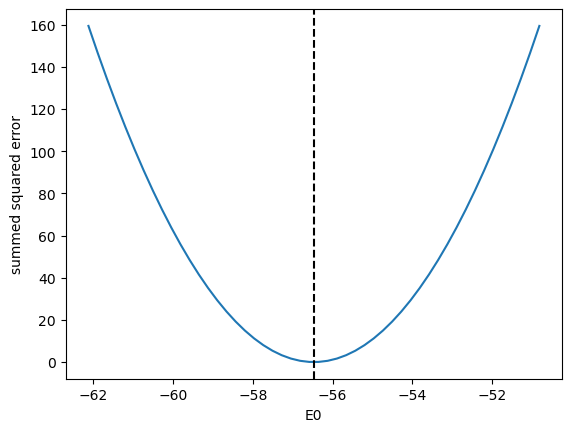
Parameter confidence intervals and curve fitting with lmfit#
We have left out an important topic in the discussion above: How certain are we of the parameters we estimated? This is a complicated question that requires moderately sophisticated statistics to answer. We discussed how to do this at the end of 06-262, and we used a special python package lmfit to do so!
lmfit has some nice properties:
It’s easy to use
It’s general for non-linear curve fitting problems
It handled various loss functions
It handles the basic statistics of linear uncertainty analysis for you
See also
https://lmfit.github.io/lmfit-py/
from lmfit import Model
def MurnaghanLmfit(vol, E0, B0, BP, V0):
"From PRB 28,5480 (1983)"
E = E0 + B0 * vol / BP * (((V0 / vol) ** BP) / (BP - 1) + 1) - V0 * B0 / (BP - 1.0)
return E
gmodel = Model(
MurnaghanLmfit, independent_vars=["vol"], param_names=["E0", "B0", "BP", "V0"]
)
params = gmodel.make_params(
E0=energies[imin], B0=B[imin], BP=Bp[imin], V0=volumes[imin]
)
result = gmodel.fit(energies, params, vol=volumes)
print(result.fit_report())
vfit = np.linspace(min(volumes), max(volumes))
fitted_energies = result.eval(vol=vfit)
plt.plot(volumes, energies, "bo", label="Data")
plt.plot(vfit, fitted_energies)
plt.legend()
plt.xlabel("V")
plt.ylabel("E")
[[Model]]
Model(MurnaghanLmfit)
[[Fit Statistics]]
# fitting method = leastsq
# function evals = 73
# data points = 5
# variables = 4
chi-square = 1.4913e-05
reduced chi-square = 1.4913e-05
Akaike info crit = -55.6135982
Bayesian info crit = -57.1758466
[[Variables]]
E0: -56.4683965 +/- 0.00303671 (0.01%) (init = -56.463)
B0: 0.57233308 +/- 0.04018672 (7.02%) (init = 0.02575384)
BP: 2.74075619 +/- 1.42020815 (51.82%) (init = -0.009004059)
V0: 16.5590580 +/- 0.06876072 (0.42%) (init = 17.23)
[[Correlations]] (unreported correlations are < 0.100)
C(BP, V0) = -0.832
C(B0, BP) = -0.820
C(E0, B0) = -0.773
C(E0, BP) = 0.548
C(B0, V0) = 0.451
C(E0, V0) = -0.319
Text(0, 0.5, 'E')
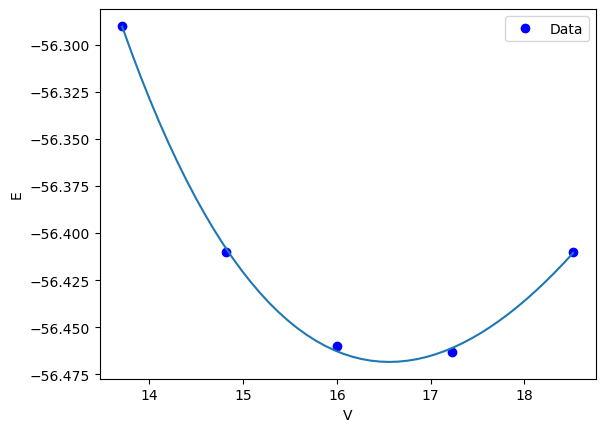
Summary#
Today we introduced the concept of finding minima/maxima in functions. This is an iterative process, much like finding the roots of a nonlinear function. You can think of it as finding the zeros of the derivative of a nonlinear function! This method is the root of many important optimization problems including regression.
scipy.optimize.minimize is the preferred function for doing minimization. There are other more specific ones described at https://docs.scipy.org/doc/scipy/reference/optimize.html, but minimize has a more consistent interface and provides almost all the functionality of those other methods. We also discussed how heuristic global optimization can be used to find function global minima.
We covered a lot of ground today. The key points are:
Regression is a minimization of an accumulated error function.
If you need uncertainty on the parameters from a regression, use
lmfitor another package to handle the statistics, but think about the assumptions being made!If you need uncertainty on model predictions, you can either simulate it, or derive it. We will learn more about deriving it later in the context of machine learning models.



